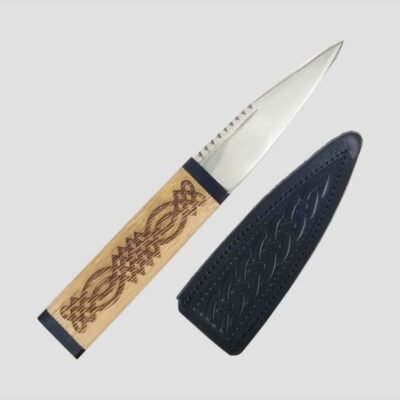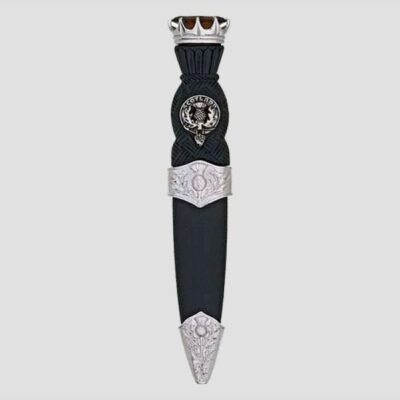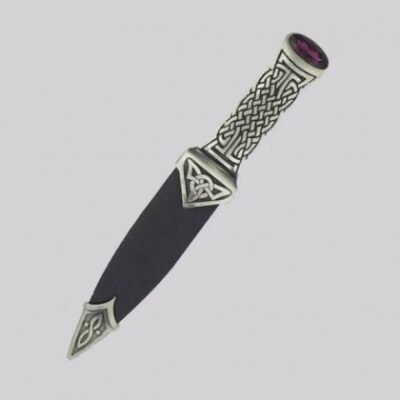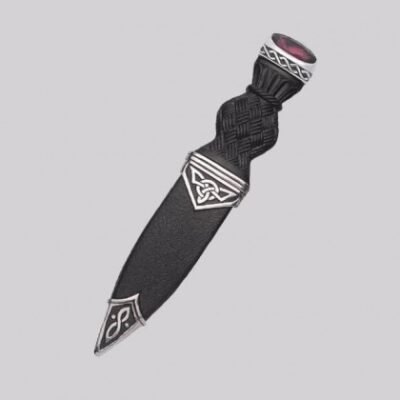BLACK CHROME PIP TOP CELTIC DESIGN SGIAN DUBH
Original price was: $90.$45Current price is: $45.BLACK CHROME PIP TOP CELTIC DESIGN SGIAN DUBH
The sgian dubh is small—almost easy to overlook at first. But once you know what it is, it’s hard not to notice it. That little blade tucked neatly into the sock, barely visible, yet undeniably important. There’s something quietly symbolic about it. Not showy, not loud. Just… present.
You don’t wear one just to check off a box. At least, you shouldn’t. A Scottish sgian dubh carries tradition—steeped in Highland history. It was a utility knife, originally. Practical. But today, it’s more than that. It’s ceremonial, yes, but also personal.
Let’s be honest—some people skip it. Maybe it feels like too much, or maybe they think no one will notice. But those who do wear one know better. A sgian dubh knife adds detail. It completes the outfit in a way that feels… intentional.
There’s weight to it—not just the physical kind. You wear it, and suddenly the rest of the outfit feels anchored. I’ve seen folks adjust it just slightly before stepping into a wedding, or a formal dinner, almost like a ritual. Small, but meaningful.
We carry both. The polished modern looks are sleek and timeless, sure. But there’s something about an antique sgian dubh—the aged handle, the carved detail—that feels different. Like you’re wearing a fragment of the past.
If you’re looking for a sgian dubh for sale, something that fits your personality (or your tartan), there’s a lot to choose from. Ebony wood, stag horn, Celtic knotwork… it comes down to what speaks to you.
Showing all 6 results

BLACK CHROME PIP TOP CELTIC DESIGN SGIAN DUBH


Celtic Knot Scottish Sgian Dubh


PEWTER BOISDALE SGIAN DUBH WITH STONE HILT

POLISHED PEWTER CELTIC SGIAN DUBH WITH STONE HILT
 Customer Testimonials
Customer TestimonialsA Sgian Dubh is a small ceremonial knife traditionally worn in the sock of a man’s Highland dress. It’s often part of full kilt outfits and reflects Scottish heritage.
Most decorative or non-sharp Sgian Dubhs are legal for ceremonial wear. Check local laws, especially if traveling with a sharp blade.
We offer both. Some have sharpened blades (great for collectors or ceremonial use), while others are for display and safe for public wear.
Traditionally, yes. It completes the look and symbolizes readiness and pride in Scottish culture.

A sgian dubh might look modest—just a small knife tucked into your sock. But it carries a quiet weight. Not just physically—it’s sharp, after all—but symbolically. It’s a nod to tradition. A reminder of history. And yes, sometimes a conversation starter.
I remember the first time I wore one. I was a bit self-conscious, to be honest. But when someone asked, with genuine curiosity, “Is that a real sgian dubh knife?”—well, that question alone makes it worth wearing. Especially when you get to explain its place in Scottish dress.
At its simplest, a Scottish sgian dubh is a small, single‑edged knife traditionally worn tucked into the hose, with only the pommel visible. It originated as a utility knife. Over time, it became part of formal Highland dress. Now it’s mostly ceremonial—or practical, depending on who you ask.
Look closely, and you’ll find different styles: some with simple handles of wood or horn, others featuring metal, carvings, or even gemstone inlays. Antique sgian dubh examples are especially interesting. They often have wear you can feel and stories hidden in scars or patina.
How to wear a sgian dubh is both simple and a little cultural. It slips into your right sock (or hose), point down, tucked above the garter or top. The handle peeks out, positioned around the calf. If it’s too low… well, it shifts during walking. Too high? It looks awkward. It needs just-right placement.
And yes, there are regional preferences and small etiquette notes—like keeping it side‑on, not front-on. But most people are more relaxed about it now. Unless you’re in full formal dress at a clan event, then details matter.
Choosing a sgian dubh knife goes beyond just size. You want design that fits your style and matches the rest of your outfit—belt buckle, sporran, cufflinks. Simple metal handles feel timeless and formal. Wooden or antler grips add rustic character. Some are boxed with decorative sheaths; others come sleek, knife‑only.
Antique versions feel cooler in person. You can sometimes even see the craftsman’s tool marks. A few of those old blades need sharpening, and maybe a handle stabilized—but that imperfect finish? It carries authenticity.
There’s a difference between a traditional sgian dubh and modern utility pieces. The traditional ones follow design from the 18th and 19th centuries—simple blade shapes, classic handles. Modern versions might borrow from hunting knife styling, with thicker grips or stainless steel blades better for outdoor use.
If you’re primarily wearing one on formal occasions, a traditional style is likely all you need. But if you actually use it—camping, cutting ribbons, opening packages—it could double as a practical tool. Something to keep in mind when browsing the sgian dubh for sale.
When you’re shopping sgian dubh for sale, whether new or antique, look for balance. Weight matters—if it’s too heavy, it shifts; too light, and it looks insubstantial. Check the blade length too. It shouldn’t poke out during walking or look like a dagger. Most are around 3–4 inches.
We list pieces with clear close‑ups, each tagged by style—traditional, antique, utility. Some include display boxes. Others are sold ready to wear, with sheaths and shoulder flaps. We want to make sure you know exactly what kind of Scottish sgian dubh you’re getting.
Almost all of these little knives need a bit of upkeep. Steel blades benefit from occasional oiling to prevent rust. Wooden handles might dry out unless you treat them. Antique knives often come with a note about when, how they’re best cared for.
If you’ve got a vintage piece—or maybe one you inherited—you might notice the handle loosen over decades. That’s fixable. And the repair itself becomes part of its story.
A sgian dubh isn’t mandatory. Many wear full Highland dress without one. But wearing one subtly—handle visible just over the top of your hose—can feel right. It’s that tipping point between history and presence; utility and ceremony. Plus, when someone notices? It often starts a story you didn’t know you’d carry.
Explore our collection of sgian dubh pieces—traditional, modern, antique—and find the one that feels like yours. Because sometimes, it’s the small details that carry the biggest meaning.